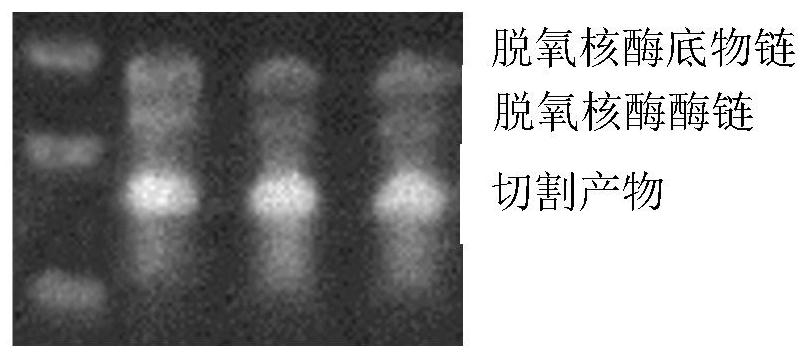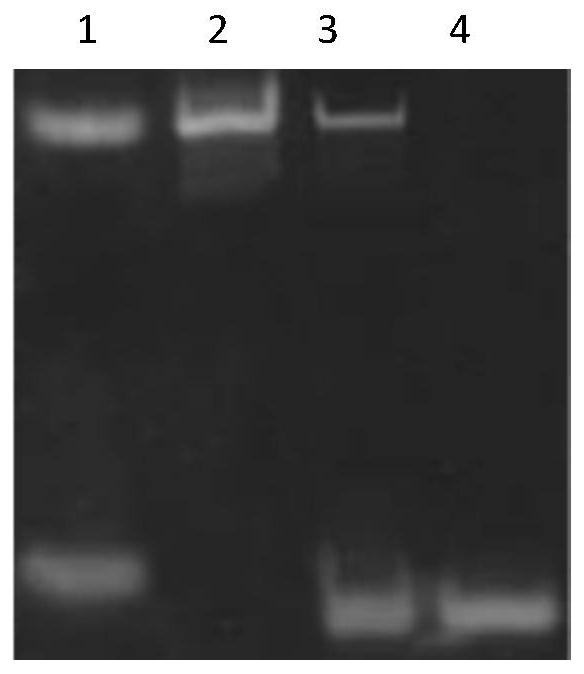A high-salt-resistant colorimetric sensor based on zinc-based functional nucleic acid and its application
A technology of colorimetric sensors and functional nucleic acids, applied in instruments, scientific instruments, genetic engineering, etc., can solve the problems of poor selectivity, high price, and low sensitivity, and achieve the effects of low cost, high sensitivity, high specificity, and sensitivity
- Summary
- Abstract
- Description
- Claims
- Application Information
AI Technical Summary
Problems solved by technology
Method used
Image
Examples
Embodiment 1
[0054] Example 1: Construction of a high-salt-resistant colorimetric sensor based on zinc-based functional nucleic acids
[0055] 1. Experimental materials
[0056] Potassium Chloride, Sodium Chloride, Magnesium Chloride, Potassium Hydrogen Phosphate, Disodium EDTA, Thioflavin, Zinc Chloride, Urea, Nt.BstNBI Nicking Endonuclease, Bst DNA Polymerase, 4-Hydroxy Ethylpiperazineethanesulfonic Acid (HEPES), Sodium Hydroxide, Disodium Hydrogen Phosphate.
[0057] 2. Sequence design
[0058] Design and synthesize DNAzyme substrate strands, DNAzyme enzyme strands, and amplification templates. In the amplification template, GACTC is the Nt.BstNBI nicking endonuclease recognition sequence, and the first four base pairs of the sequence (between C and A) are the synthetic chain cleavage sites; the zinc ion cleavage site is at the base of the deoxyribozyme After A in the chain of things A.
[0059]
[0060] 3. Construction method
[0061] The construction method of the high-salt re...
Embodiment 2
[0078] Embodiment 2: the detection of zinc ion
[0079] The zinc ion solution to be measured is a zinc chloride solution (NaCl is a dissolution environment), and the specific steps are as follows:
[0080] (1) Prepare the standard curve of fluorescence intensity changing with zinc ion concentration
[0081] Using the construction method of 3 in Example 1, the zinc ion solution to be tested is selected as zinc chloride solution (1M NaCl is the dissolution environment), the zinc ion concentration is 25pM, 50pM, 75pM, 100pM and 125pM, and the excitation wavelength is set at 425nm to prepare Standard curve of fluorescence intensity (FL) varying with zinc ion concentration at a wavelength of 485nm ( image 3 ), the standard curve is y=106.22x+893.33, R 2 = 0.9941.
[0082] (2) Using the construction method of 3 in Example 1, measure the fluorescence intensity of the zinc ion solution to be tested, and bring it into the standard curve y=106.22x+893.33 to obtain the zinc ion conce...
Embodiment 3
[0085] Embodiment 3: A kind of test kit that detects zinc ion
[0086] A kit for detecting zinc ions, comprising a zinc ion deoxyribozyme system, an isothermal amplification system and a display system;
[0087] Zinc ion deoxyribozyme system includes substrate chain, enzyme chain, buffer, zinc ion standard solution and stop solution;
[0088] The isothermal amplification system includes amplification template, dNTPs, ultrapure water, Bst DNA polymerase, polymerase reaction buffer solution, Nt.BstNBI nicking endonuclease and Nt.BstNBI nicking endonuclease reaction buffer solution;
[0089] The display system includes: thioylavin stock solution and display buffer.
[0090] The sequence (5'-3') of the deoxyribozyme substrate chain is: GCTAGAGATTTTCCACACTGATGCAGACGTTGAAGGATTATCTACTAAAAGGGTCTGAGGG;
[0091] The sequence (5'-3') of the deoxyribozyme enzyme chain is: AGATAATCTAGTTGAGCTGTCTGCAT;
[0092] The sequence (5'-3') of the amplification template is: CCCAACCCGCCCTACCCCCCAAC...
PUM
 Login to View More
Login to View More Abstract
Description
Claims
Application Information
 Login to View More
Login to View More - R&D
- Intellectual Property
- Life Sciences
- Materials
- Tech Scout
- Unparalleled Data Quality
- Higher Quality Content
- 60% Fewer Hallucinations
Browse by: Latest US Patents, China's latest patents, Technical Efficacy Thesaurus, Application Domain, Technology Topic, Popular Technical Reports.
© 2025 PatSnap. All rights reserved.Legal|Privacy policy|Modern Slavery Act Transparency Statement|Sitemap|About US| Contact US: help@patsnap.com



